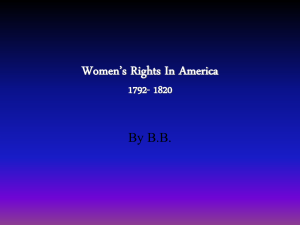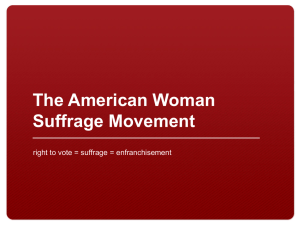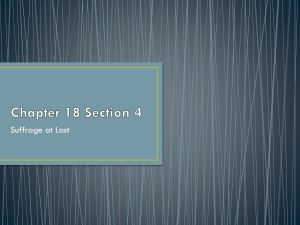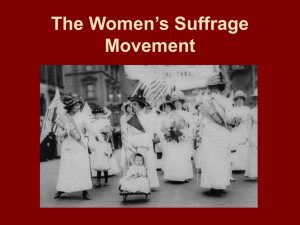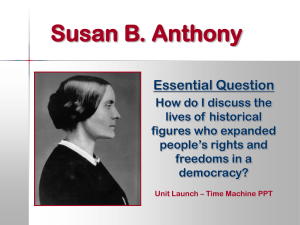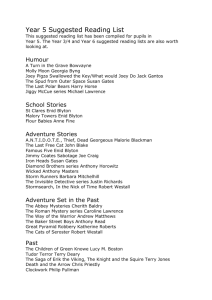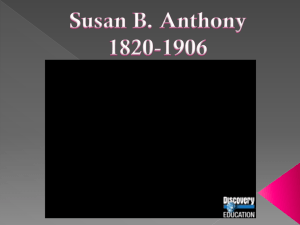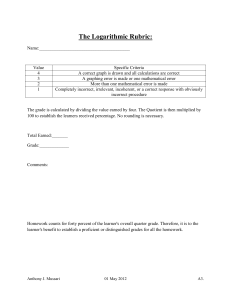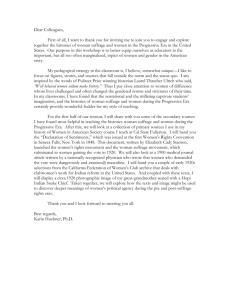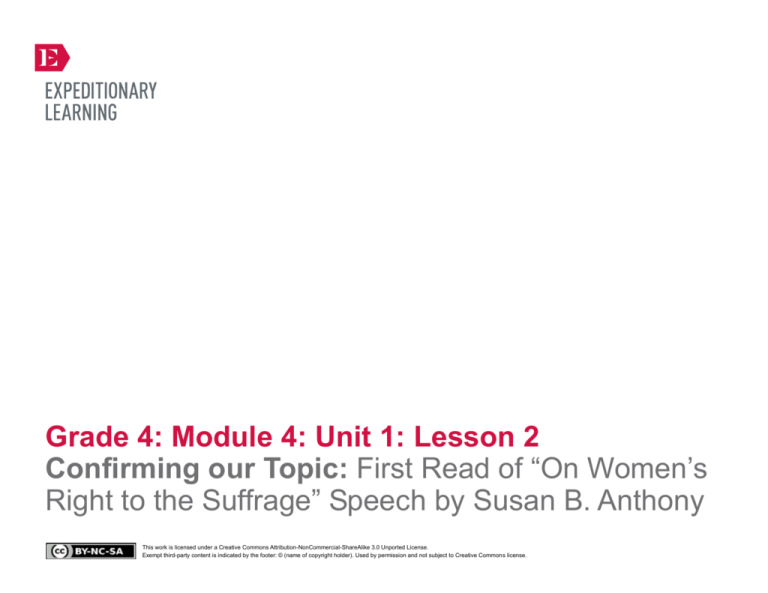
Grade 4: Module 4: Unit 1: Lesson 2
Confirming our Topic: First Read of “On Women’s
Right to the Suffrage” Speech by Susan B. Anthony
This work is licensed under a Creative Commons Attribution-NonCommercial-ShareAlike 3.0 Unported License.
Exempt third-party content is indicated by the footer: © (name of copyright holder). Used by permission and not subject to Creative Commons license.
GRADE 4: MODULE 4: UNIT 1: LESSON 2
Confirming our Topic:
First Read of “On Women’s Right to the Suffrage” Speech by Susan B. Anthony
Long-Term Learning Targets
I can explain what a text says using specific details from the text. (RI.4.1)
I can make inferences using specific details from the text. (RI.4.1)
I can determine the meaning of academic words or phrases in an informational text. (RI.4.4)
I can determine the meaning of content words or phrases in an informational text. (RI.4.4)
Supporting Learning Targets
Ongoing Assessment
• I can infer the meaning of words and phrases using context clues to better understand a primary source.
• Close Reading recording form: “On Women’s Rights to
Suffrage” paragraph 1
• I can explain points made in a speech using details from the text.
Copyright © 2013 by Expeditionary Learning, New York, NY. All Rights Reserved.
NYS Common Core ELA Curriculum • G4:M4:U1:L2 • June 2014 •
1
GRADE 4: MODULE 4: UNIT 1: LESSON 2
Confirming our Topic:
First Read of “On Women’s Right to the Suffrage” Speech by Susan B. Anthony
Agenda
Teaching Notes
1. Opening
A. Engaging the Reader (5 minutes)
• In this lesson students will confirm their topic of study for this module to be women’s suffrage by
reading an excerpt of “On Women’s Right to the Suffrage”, a speech by Susan B. Anthony given in 1873.
B. Reviewing Learning Targets and Close Reading
Anchor Chart (5 minutes)
• This is a challenging primary source document. Students will revisit sections throughout the entire
module.
2. Work Time
A. Listening for Gist: Confirming Our Topic? (10
minutes)
B. Close Read of Paragraph 1 of “On Women’s Right to
Suffrage” by Susan B. Anthony (35 minutes)
3. Closing and Assessment
A. Sharing/Debrief: Concentric Circles (5 minutes)
4. Homework
• During Unit 1, students will read this speech excerpt in both this lesson (to pique their interest about the
topic and the speaker) and then again in Lesson 10 (after they have read several texts about women’s
suffrage and Susan B. Anthony).
• There is no expectation that students will fully understand this text at this point. The most important
point students should understand from the text is that Susan B. Anthony believed that women should
have the right to vote and at the time of this speech it was against the law.
• In Unit 2 students will again revisit parts of this speech to make connections to a piece of historical
fiction they will read. The novel, The Hope Chest by Karen Schwabach, is set during the passage of the
19th amendment.
• Finally, in Unit 3 students will again revisit the speech to prepare for their performance task, a letter to
high school seniors about the importance of voting.
• In this lesson, students hear the entire speech read aloud, and then focus on just paragraph 1.
• Students will work with a partner during this lesson. Decide whether you will be placing them with a
partner or allowing them to choose their own partner.
• Be sure students have a folder to keep texts, notes, and their writing for this module.
• In advance: Review Module 1, Unit 1, Lessons 3 and 4. Much of the work of this lesson is designed to
reinforce work students did early in the year with another challenging primary source document: the
Iroquois Constitution.
• Write the following question on the board: “Is it ever okay to break the law?”
• Review: Helping Students Read Closely and Concentric Circles (Appendix 1).
Copyright © 2013 by Expeditionary Learning, New York, NY. All Rights Reserved.
NYS Common Core ELA Curriculum • G4:M4:U1:L2 • June 2014 •
2
GRADE 4: MODULE 4: UNIT 1: LESSON 2
Confirming our Topic:
First Read of “On Women’s Right to the Suffrage” Speech by Susan B. Anthony
Lesson Vocabulary
Materials
infer, context clues, primary source,
suffrage; alleged, citizens, deny,
exercised indictment, lawful, right
(paragraph 1)
• Close Readers Do These Things anchor chart (from Module 1, Unit 1, Lesson 3 or recreated from supporting materials of this
lesson)
• Document camera
• “On Women’s Right to the Suffrage” by Susan B. Anthony (one per student and one for display)
• Close Reading recording form: “On Women’s Rights to Suffrage” paragraph 1 (one per student)
Opening
Meeting Students’ Needs
A. Engaging the Reader (5 minutes)
• Review the homework from Lesson 1: “Think about the question ‘Is it ever OK to break the law? Why or why not?’ Write a
short statement with your opinion on this question and reasons for this opinion.”
• Consider allowing ELLs extra think
time for the Think-Pair-Share, giving
them the question in advance or
pairing them with a partner who speaks
the same home language.
• Reassure students that you are not looking for a right or wrong answer to this question, just their opinion and reasons.
Students should be comfortable stating an opinion with supporting reasons from the last module (Module 3).
• Ask students to turn to a partner and share their response to the homework. After allowing a few minutes for discussion,
cold call a few pairs to share their responses.
• After a few pairs have shared their opinions, tell students that in the next few days they will have an opportunity to think
about this question as they begin to study a new topic.
• Remind them that yesterday they read a timeline about the history of voting in America. Explain that in today’s lesson it
will be their job to discover which part of this history will be their topic of study for the next several weeks.
Copyright © 2013 by Expeditionary Learning, New York, NY. All Rights Reserved.
NYS Common Core ELA Curriculum • G4:M4:U1:L2 • June 2014 •
3
GRADE 4: MODULE 4: UNIT 1: LESSON 2
Confirming our Topic:
First Read of “On Women’s Right to the Suffrage” Speech by Susan B. Anthony
Opening (continued)
Meeting Students’ Needs
B. Review Learning Targets and Close Reading Anchor Chart (5 minutes)
• Post the Close Readers Do These Things anchor chart and the learning targets where students can see them. Tell students
that today they will read a speech that was given a long time ago (1873). Explain that it is a primary source. They should
be familiar with this term from its use in Module 1 with the “Great Law of Peace” and Module 2 with the “Inventory of
John Allen.” If students do not recall the meaning of primary source, remind them that it is “any piece of information that
was created by someone who witnessed firsthand or was part of the historical events that are being described.”
• Some students may benefit from having
this anchor chart typed and copied for
their notes or reading folder for quick
reference.
• Read the following learning target to students: “I can infer the meaning of words and phrases using context clues to
better understand a primary source.” Ask students to turn to a partner and explain what this learning target means in
their own words.
• Cold call a few pairs to share their interpretations of the target and clarify if necessary. Be sure students know that
context clues are details in the text that help readers to understand a word or phrase.
• Follow a similar procedure to clarify the meaning of the second learning target: “I can explain points made in a speech
using details from the text.”
• Explain that because primary sources often use unfamiliar language, this can make them difficult to understand without
a close read. Review the Close Readers Do These Things anchor chart with students (see supporting materials):
– Read small chunks of text slowly and think about the gist.
– Reread each passage one sentence at a time.
– Underline things that you understand or know something about.
– Circle words that you do not know.
– Talk with your partners about all of your good ideas.
– State the gist or message of the paragraph in the margin.
– Listen to the questions.
– Go back to the text to find answers to questions.
– Talk with your partners about the answers you find.
• Tell students that today they will read for the gist and do not need to understand everything they read in the text. Explain
that reading for the gist of the text will help them to discover their topic of study.
Copyright © 2013 by Expeditionary Learning, New York, NY. All Rights Reserved.
NYS Common Core ELA Curriculum • G4:M4:U1:L2 • June 2014 •
4
GRADE 4: MODULE 4: UNIT 1: LESSON 2
Confirming our Topic:
First Read of “On Women’s Right to the Suffrage” Speech by Susan B. Anthony
Work Time
Meeting Students’ Needs
A. Listening for Gist: Confirming Our Topic? (10 minutes)
• Place students with a partner for reading and discussion. Using a document camera, display “On Women’s Right to
the Suffrage” by Susan B. Anthony. Distribute this text to students as well.
• For students who struggle with
complex texts, consider enlarging a
copy of “On Women’s Right to the
Suffrage” and printing each
paragraph on a separate page. This
can help make the text feel more
manageable.
• Tell students that you will read the text aloud while they read along silently. Remind them that they do not have to
understand all of the text but should be listening for the gist. Ask them to think about the following as you read:
* “What do you think this speech is mostly about?”
• Read the text slowly and fluently without stopping for questions or explanation.
• Afterward, ask students to think then turn to their partner and explain:
* “What is this speech about?”
• Ask a few pairs to share out their thinking. At this point students may not understand much about the text, but you may hear
them say something like: “It sounds like she is upset about being accused of a crime,” “She voted and it was a crime,” or “I
think we will be studying how women fought to get the right to vote.”
• Confirm for students that they will be studying how women fought for the right to vote in the United States. Explain that
they will read more about Susan B. Anthony and her role in this movement over the next couple of weeks, but first they will
take a closer look at the first paragraph of her speech.
• Ask students to put “On Women’s Right to the Suffrage” in their folders.
Copyright © 2013 by Expeditionary Learning, New York, NY. All Rights Reserved.
NYS Common Core ELA Curriculum • G4:M4:U1:L2 • June 2014 •
5
GRADE 4: MODULE 4: UNIT 1: LESSON 2
Confirming our Topic:
First Read of “On Women’s Right to the Suffrage” Speech by Susan B. Anthony
Work Time (continued)
Meeting Students’ Needs
B. Close Read of Paragraph 1 of “On Women’s Right to Suffrage” by Susan B. Anthony (35 minutes)
• Distribute the Close Reading recording form.
• Some students may benefit from
writing notes and answers to these
questions in the margin next to the
“Background Information”
paragraph.
• Post the following questions on the board:
* “Using context clues, what can you infer about the meaning of the word suffrage?”
* “Why was Susan B. Anthony arrested?”
• Tell students that with their partner you would like them to take 5 minutes to read the “Background Information” on the
front of their Close Reading recording form. Give students 5 more minutes to discuss the questions on the board. Circulate
to listen in and gauge students’ initial understanding.
• Refocus students whole group. Cold call a few pairs to share their answers. Listen for answers like:
• “Suffrage has something to do with voting,” and “Susan B. Anthony was arrested for voting when it was against the law for
women to vote.”
• Prompt students to provide the context clues they used to determine the meaning of the word suffrage.
• Next, point out the glossary on their Close Reading recording form. Explain that this glossary will help them better
understand the first paragraph of the speech by providing the definitions of several words. Remind them of the process they
used for reading with a glossary in the previous lesson:
• Based on the needs of your
students, you may wish to add more
words to the glossary and share
their definitions in advance.
• Consider providing definitions of
work bank words in ELLs’ home
language, using an online translator
like Google Translate.
• If needed, model steps 1 and 2 of the
directions.
1. Read the text together.
2. When you come to an unfamiliar word, use the context to help understand the word.
3. If context isn’t enough, use the definitions/synonyms in the glossary.
4. If the glossary isn’t enough, use a class dictionary.
5. Reread the text together using the definitions/synonyms in place of the unfamiliar word.
• Tell students that they will use a similar process as they reread the first paragraph of the speech. Tell them that some of the
words have been left blank because they will be able to infer the meanings of these words from context clues in the text.
• Ask students to find the word suffrage and point out the following line in the “Background Information” section of the text:
“This movement held protests, marches, and rallies to try to change the constitution so women could vote.” Explain to
students that this line from the text provides a context clue so that they can infer the meaning of the word suffrage to mean
“the right to vote.” Ask students to add this definition in their glossary.
Copyright © 2013 by Expeditionary Learning, New York, NY. All Rights Reserved.
NYS Common Core ELA Curriculum • G4:M4:U1:L2 • June 2014 •
6
GRADE 4: MODULE 4: UNIT 1: LESSON 2
Confirming our Topic:
First Read of “On Women’s Right to the Suffrage” Speech by Susan B. Anthony
Meeting Students’ Needs
Work Time (continued)
• Tell them that they will have to infer the meanings of the remaining blank words (alleged and right) from the first paragraph
of the speech. Remind them that some words—like right—can have multiple meanings and that it is important to think about
the meaning of the word in context.
• Focus students on the back of the Close Reading recording form. Review the directions above the first paragraph of the
speech:
1. Follow along as the first paragraph of the speech is reread to you. Circle the words listed in the glossary and any other
words you do not know the meanings of.
2. Reread the speech with your partner using the glossary and context clues to write synonyms or explanations above
difficult words.
3. Reread the text and answer the questions in the right-hand column.
• Clarify directions as needed. Use the document camera to zoom in on the glossary. Preview the words with recorded
definitions for students. Clarify the meanings of these words as needed.
• Reread the text aloud as students follow along and circle difficult words.
• Give students 10-15 minutes to complete steps 2 and 3 of the directions. Circulate to support students as needed or pull a
small group for more direct support.
• Call the attention of the whole group to review the answers to the text-dependent questions in the right-hand column. Cold
call pairs to answer the questions and clarify as needed.
• Ask:
* “What did you read in the text that helped you come to your answer?”
• Encourage students to amend their notes as needed. For example: For Question 1. What does Susan B. Anthony mean by
“alleged crime”? A student might say: “She didn’t agree with the law against women voting.” The student should point to the
next sentence in the speech as support for that inference, “… prove to you that in thus voting, I not only committed no
crime …”
Copyright © 2013 by Expeditionary Learning, New York, NY. All Rights Reserved.
NYS Common Core ELA Curriculum • G4:M4:U1:L2 • June 2014 •
7
GRADE 4: MODULE 4: UNIT 1: LESSON 2
Confirming our Topic:
First Read of “On Women’s Right to the Suffrage” Speech by Susan B. Anthony
Meeting Students’ Needs
Work Time (continued)
• For the remaining two questions, look for answers similar to the following and prompt students to support their answers
with the text:
1. What does the word “right” mean as it is used in this text? “Something people can’t stop you from doing,” or “Something
everyone should be able to do.”
2. In 1873 it was against the law for women to vote in the state of New York as well as in other states. This speech says that
voting is a right that is “beyond the power of the state to deny.” What do you think this means? “The states can’t make
laws against voting,” or “New York isn’t allowed to keep women from voting.”
• After discussing the answers to the questions. Point out the “Gist Statement” portion of the Close Reading recording form.
• Allow 10 minutes to reread the paragraph with their partners, discuss what they think the gist of the paragraph is, and then
write a gist statement on their recording forms. Students should be prepared to share this.
Copyright © 2013 by Expeditionary Learning, New York, NY. All Rights Reserved.
NYS Common Core ELA Curriculum • G4:M4:U1:L2 • June 2014 •
8
GRADE 4: MODULE 4: UNIT 1: LESSON 2
Confirming our Topic:
First Read of “On Women’s Right to the Suffrage” Speech by Susan B. Anthony
Closing and Assessment
Meeting Students’ Needs
A. Sharing/Debrief: Concentric Circles (5 Minutes)
• Tell students that in a moment you would like them to gather in two circles, one facing in and the other facing out, for
Concentric Circles (Appendix 1). Students should face a partner they did not work with during the lesson.
• For ELLs or students who need
more time to think before answering
discussion questions, consider
allowing them to reflect on the final
discussion question before
beginning the closing of this lesson.
• For the first round of Concentric Circles, ask students to share their gist statement. Circulate and listen to gauge students’
understanding of the first paragraph of the speech. It is not likely that they will have a deep understanding of the text at this
point, but they should understand that Susan B. Anthony believed women should have the right to vote and that at the time
of this speech it was against the law. Give students 2 minutes to share and take notes or revise their gist statements before
moving to their next partner.
• Next, ask students in the outside circle to move three people to their right and remind them of the discussion question from
the beginning of the lesson: “Is it ever okay to break the law? Why or why not?” Tell them that you would like them to
discuss a different version of this question:
* “Was it OK for Susan B. Anthony to break the law? Why or why not?”
• Give students 3 minutes for this final discussion question. If time permits, ask students to move to a new partner and
continue to discuss this question.
• Collect students’ Close Reading recording forms for formative assessment.
• Discuss the night’s homework. Clarify as needed.
Meeting Students’ Needs
Homework
• Our guiding question for the next few weeks is: “What makes someone a leader of change?” Write a short statement with
your opinion on this question and your reason for this opinion.
Copyright © 2013 by Expeditionary Learning, New York, NY. All Rights Reserved.
NYS Common Core ELA Curriculum • G4:M4:U1:L2 • June 2014 •
9
Grade 4: Module 4: Unit 1: Lesson 2
Supporting Materials
This work is licensed under a Creative Commons Attribution-NonCommercial-ShareAlike 3.0 Unported License.
Exempt third-party content is indicated by the footer: © (name of copyright holder). Used by permission and not subject to Creative Commons license.
GRADE 4: MODULE 4: UNIT 1: LESSON 2
Close Readers Do These Things Anchor Chart
From Module 1, Unit 1, Lesson 3
This anchor chart should look like the following. If needed, recreate this chart with your students as
an opening to this lesson.
Close Readers Do These Things:
• Read small chunks of text slowly and think about the gist.
• Reread each passage one sentence at a time.
• Underline things that you understand or know something about.
• Circle words that you do not know.
• Talk with your partners about all of your good ideas.
• State the gist or message of the paragraph in the margin.
• Listen to the questions.
• Go back to the text to find answers to questions.
• Talk with your partners about the answers you find.
Copyright © 2013 by Expeditionary Learning, New York, NY. All Rights Reserved.
NYS Common Core ELA Curriculum • G4:M4:U1:L2 • June 2014 •
11
GRADE 4: MODULE 4: UNIT 1: LESSON 2
“On Women’s Right to Suffrage,”
Excerpt from a speech by Susan B. Anthony given in 1873
“Friends and fellow citizens: I stand before you tonight under indictment for the alleged crime of
having voted at the last presidential election, without having a lawful right to vote. It shall be my work
this evening to prove to you that in thus voting, I not only committed no crime, but, instead, simply
exercised my citizen’s rights, guaranteed to me and all United States citizens by the National
Constitution, beyond the power of any state to deny.
The preamble of the Federal Constitution says:
‘We, the people of the United States, in order to form a more perfect union, establish justice, insure
domestic tranquility, provide for the common defense, promote the general welfare, and secure the
blessings of liberty to ourselves and our posterity, do ordain and establish this Constitution for the
United States of America.’
It was we, the people; not we, the white male citizens; nor yet we, the male citizens; but we, the whole
people, who formed the Union. And we formed it, not to give the blessings of liberty, but to secure
them; not to the half of ourselves and the half of our posterity, but to the whole people—women as
well as men. And it is a downright mockery to talk to women of their enjoyment of the blessings of
liberty while they are denied the use of the only means of securing them provided by this democraticrepublican government—the ballot.”
1200L/FK 10.7
"The History Place - Great Speeches Collection: Susan B. Anthony Speech - Women's Right to Vote." The History Place - Great Speeches Collection: Susan B.
Anthony Speech - Women's Right to Vote. N.p., n.d. Web. http://www.historyplace.com/speeches/anthony.htm
Copyright © 2013 by Expeditionary Learning, New York, NY. All Rights Reserved.
NYS Common Core ELA Curriculum • G4:M4:U1:L2 • June 2014 •
12
GRADE 4: MODULE 4: UNIT 1: LESSON 2
Close Reading Recording Form
“On Women’s Right to Suffrage” by Susan B. Anthony, Paragraph 1
Name:
Date:
Background Information
In the 1800s, women the United States did not have the same rights as men. It was against the law
for them to vote. A woman named Susan B. Anthony helped lead a movement known as the women’s
suffrage movement. This movement held protests, marches, and rallies to try to change the
Constitution so women could vote. In 1872, in New York state, Susan B. Anthony was arrested for
illegally voting during a presidential election. After her trial, she traveled the country giving the “On
Women’s Right to the Suffrage” speech.
Written by Expeditionary Learning for Instructional Purposes. Sources: “Order in the Court: by Ira Peck and Kathy Wilmore, Junior Scholastic, March 10, 2008.
http://memory.loc.gov/ammem/naw/nawshome.html http://www.historyplace.com/speeches/anthony.htm
Glossary
Word
Definition
alleged
deny
to refuse to give or allow something; decline
committed
to do or perform
exercised
to put into practice or make use of; apply
indictment
to be formally accused of a crime; charge,
accusation
lawful
allowed by the law; legal
right
suffrage
Copyright © 2013 by Expeditionary Learning, New York, NY. All Rights Reserved.
NYS Common Core ELA Curriculum • G4:M4:U1:L2 • June 2014 •
13
GRADE 4: MODULE 4: UNIT 1: LESSON 2
Close Reading Recording Form
“On Women’s Right to Suffrage” by Susan B. Anthony, Paragraph 1
Directions:
• Follow along as the first paragraph of the speech is reread to you. Circle the words listed in the
glossary and any other words you do not know the meanings of.
• Reread the speech with your partner using the glossary and context clues to write synonyms or
explanations above difficult words.
• Reread the text and answer the questions in the right hand column.
“On Women’s Right to the
Suffrage,”
a Speech by Susan B. Anthony,
1873
Use the text to answer the following questions:
Friends and fellow citizens: I stand
What does Susan B. Anthony mean by “alleged crime”?
before you tonight under indictment
for the alleged crime of having voted
at the last presidential election,
without having a lawful right to vote.
It shall be my work this evening to
What does the word “right” mean as it is used in this text?
prove to you that in thus voting, I not
only committed no crime, but,
instead, simply exercised my citizen’s
rights, guaranteed to me and all
United States citizens by the National
Constitution, beyond the power of any
state to deny.
1200L/FK 10.7
Source: http://www.historyplace.com/speeches/anthony.htm
Copyright © 2013 by Expeditionary Learning, New York, NY. All Rights Reserved.
NYS Common Core ELA Curriculum • G4:M4:U1:L2 • June 2014 •
14
GRADE 4: MODULE 4: UNIT 1: LESSON 2
Close Reading Recording Form
“On Women’s Right to Suffrage” by Susan B. Anthony, Paragraph 1
“On Women’s Right to the
Suffrage,”
a Speech by Susan B. Anthony,
1873
Use the text to answer the following questions:
In 1873 it was against the law for women to vote in the state
of New York as well as in other states. This speech says that
voting is a right that is “beyond the power of the state to
deny.” What do you think this means?
Gist Statement
What is this paragraph mostly about?
Copyright © 2013 by Expeditionary Learning, New York, NY. All Rights Reserved.
NYS Common Core ELA Curriculum • G4:M4:U1:L2 • June 2014 •
15

